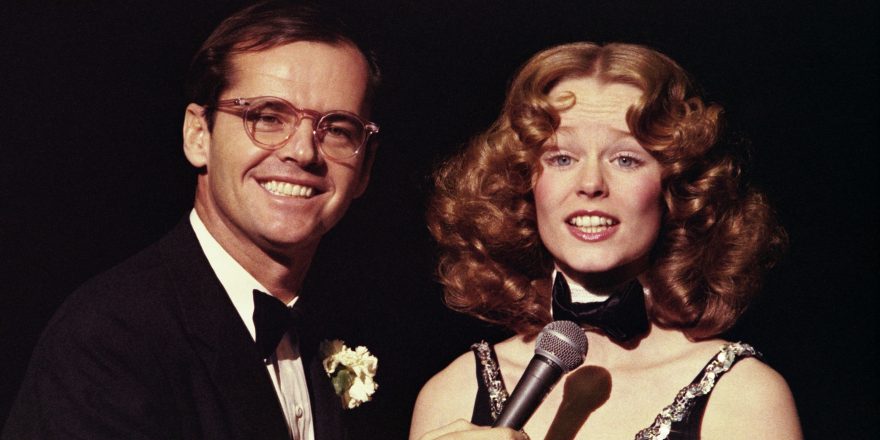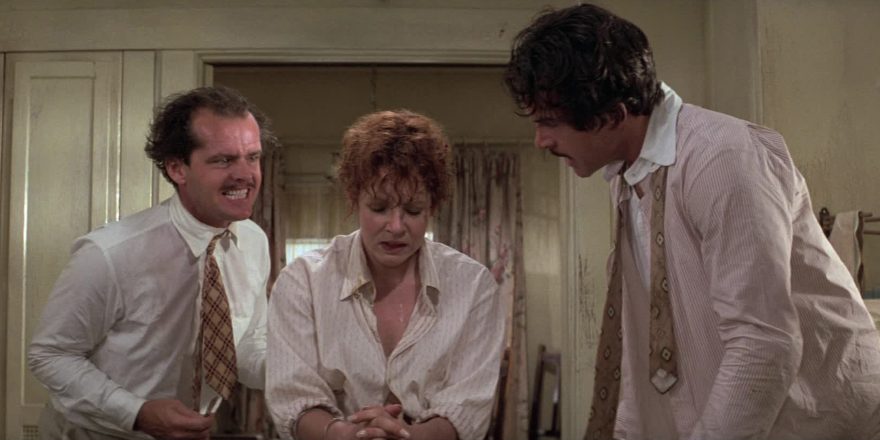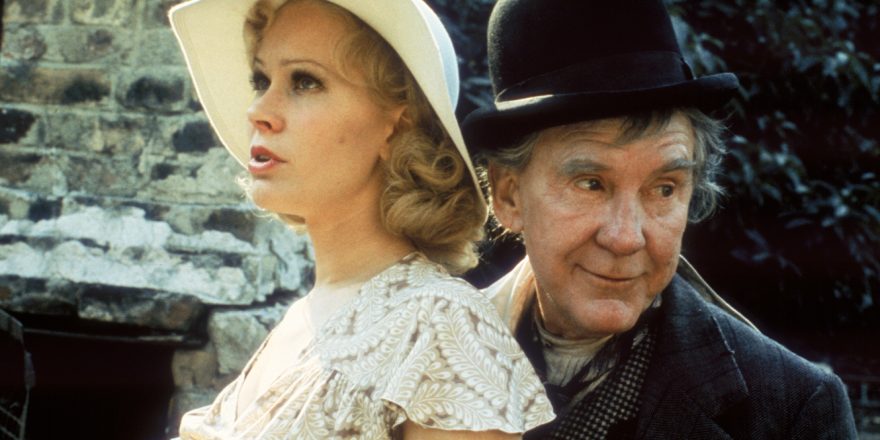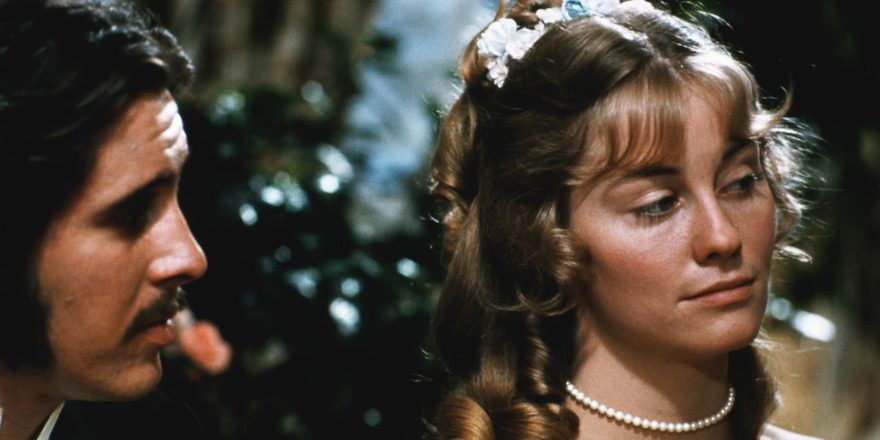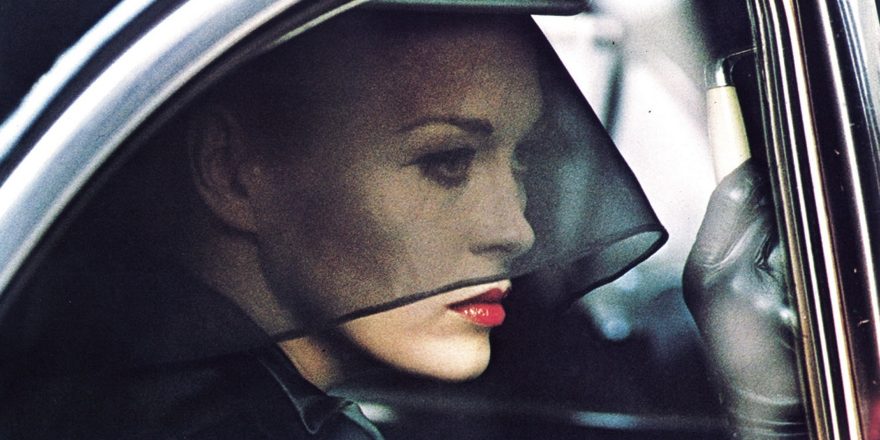As a teenager living on a small farm in Canada, I had only two TV stations to choose from. One night, an odd movie came on the late, late show. Jack Nicholson, wearing what would be known five years later as Annie Hall glasses, appears, in close-up, half in shadow, delivering a close to six-minute monologue without a cut. The opening line of the film, “I promised that I would tell you why I never eat fish,” introduces his story about how his grandfather choked to death on a fishbone while he and his older brother withheld a heel of “incriminating pumpernickel” that might have cleared his gullet and saved his life. After five minutes and 45 seconds, a red flashing light falls across Nicholson’s face, revealing that he is the host of a late-night radio show. He has been interrupted by a call from his brother Jason (Bruce Dern), who’s in jail in Atlantic City and wants him to come immediately to bail him out. “This has been Etcetera, and I’m your host, David Staebler,” he says, signing off, not sounding stable at all. I was completely mesmerized and somewhat disoriented by this opening scene, which seemed to me, as an impressionable kid starving for culture, some kind of new and radical style of filmmaking.
The film, of course, was The King of Marvin Gardens (1972), Bob Rafelson’s follow-up to his trenchant, highly acclaimed, Oscar-nominated second feature, Five Easy Pieces (1970), and although it isn’t quite the subversive masterpiece I thought it was back then, I still have a soft spot for it. (The critics savaged it upon its release, but if you read this column, you know how often they miss the mark!) Rafelson’s first film as a director, Head (1968), a vehicle for the Monkees, the Prefab Four he co-created, is a giddy, iconoclastic hallucination that remains a cult classic, way ahead of its time in its postmodernist foregrounding of the entertainment spectacle. He was an uncredited producer on both Dennis Hopper’s Easy Rider (1969) and Peter Bogdanovich’s The Last Picture Show (1971), and his company BBS, founded with Bert Schneider, is often identified as a key player in the “American New Wave” or “New Hollywood” movement, a series of films from the late ’60s to the early ’80s that deconstructed Hollywood conventions and mythologies. (Rafelson, however, was no Hollywood outsider – his uncle, Samson Raphaelson, wrote 11 pictures for Ernst Lubitsch!) This kind of maverick filmmaking led him to direct Five Easy Pieces, the film that perfectly encapsulated the countercultural zeitgeist resulting from Vietnam War fatigue and Nixon-era cynicism. (BBS would go on to produce the ultimate anti-Vietnam war documentary, Hearts and Minds.)
The King of Marvin Gardens is perhaps one of the most compelling of these harsh reassessments of the Hollywood dream machine, a meditation on loneliness and false hope that feels almost novelistic in tone and narrative structure. Based on a short work of fiction that Rafelson wrote as a college freshman, the film is essentially about writer’s block, or at least about a writer who has become disillusioned with his own words and thoughts, which he can only speak directly into a tape recorder. As the credit sequence begins, Nicholson’s David leaves the radio station in his depressing brown overcoat, a series of painterly shots (think Edward Hopper) externalizing the bleakness of his inner life. (László Kovács shot the film, a key cinematographer in the American New Wave, having also lensed Easy Rider and Five Easy Pieces.) David dines alone while a table of deaf people converse in the background, a perfect metaphor for his alienation. A shot of him riding on the streetcar brings to mind Coppola’s The Conversation (1974), another film of the era about a lonely character disillusioned with his calling, the detached use of voice recordings a major motif in both works. When he arrives home, his grandfather greets him with a sarcastic cough, suggesting that his earlier monologue had been highly embellished.
The King of Marvin Gardens is perhaps one of the most compelling of the harsh reassessments of the Hollywood dream machine, a meditation on loneliness and false hope that feels almost novelistic in tone and narrative structure.The film follows the same basic narrative structure as Five Easy Pieces, Nicholson playing in both movies a character on a quest to reconnect with an alienated family member. David leaves Philadelphia for Atlantic City to help out his brother, an eccentric grifter who still wants to “talk island,” his dream of owning a Hawaiian island with his little brother, to be called “Staebleravia.” Jason Staebler is the louche embodiment of Uncle Sam himself: capitalistic, entrepreneurial, debauched, and deluded, manifestly corrupt in the pursuit of his destiny. He inhabits the capitalist fantasy world of Monopoly, as the title implies, already having landed in jail without passing Go and – with debts to mobsters piling up – without collecting $200. Dern is perfect as the big-talking charmer with a dark side, an elemental part of his screen persona. His chemistry with Nicholson is palpable, perhaps because they are both alumni of Roger Corman’s American International Pictures, a B-movie factory that allowed them to cut their teeth on horror and biker films, respectively. (D.P. Kovács was also an AIP alum.) Nicholson’s screen persona usually vacillates between cerebral, introspective characters and wild extroverts (or in The Shining, for example, both); here he plays the former, a variation on his Bobby Dupea character in Five Easy Pieces, an intellectual who rejects his own academic pretensions but can’t quite adjust to the complications and responsibilities of the real world.
David is greeted at the train station by Sally (Ellen Burstyn, in a deliciously unhinged performance) sporting a fur coat and a corsage, a “Welcome” sash, white leather boots and big hair. She has organized a band, which plays perfunctorily in the background, almost as an afterthought. After getting his brother out of jail, David is introduced to Jason’s world, which consists of a strange three-way relationship with aging go-go girl Sally and her younger companion Jessie (Julia Anne Robinson) on one side, and a variety of black gangsters, presented in full blaxploitation mode, on the other. (Nicholson’s scenes with gangster boss Lewis, played by Scatman Crothers, prefigure the disturbing use of blaxploitation tropes in their dual appearance in The Shining.) All this is set against the backdrop of a decaying, pre-casino Atlantic City, the landmarks of its glory days still barely intact: Lucy the Margate Elephant, the Sky Tower, the Essex Carlton Hotel, Captain Starn’s Restaurant, the Steel Pier, Club Harlem, and the legendary boardwalk. It’s a superb document of a city in its winter days, the winter setting only reinforcing its melancholy.
Through a crack in a hotel bedroom door, David witnesses Jason engage in a disturbing topless water gun fight with Sally and Jessie, which sets the stage for the family romance tragedy to come. We eventually discover that Jessie is Sally’s stepdaughter, adding an incestuous dimension to their polyamorous setup. (Apparently, the script originally had them as mother and daughter, but it was deemed too controversial.) Julia Ann Robertson gives an extraordinarily raw performance as the all-American girl gone wrong. Sadly, it would prove to be her only starring role. She died three years later, at the age of 24, in a fire caused by smoking in bed. Sigh.
The King of Marvin Gardens is the kind of personal, low-key character study that really doesn’t get made in Hollywood anymore. The film, made at a time before “sticks” became a bad word in film production, is as much about the romance of mise-en-scène and the lost art of composition than anything else. The use of silhouette, the shots of the brothers comically racing each other on the beach, or sitting on horseback, facing each other, or walking forlornly on the boardwalk, are enormously pleasing on a purely aesthetic level. The scene in the empty convention hall, in which the foursome acts out the bygone fantasy of a Miss America pageant – an institution, at that time, as decrepit as Atlantic City – is shot in harsh spotlight, revealing the tattered reality of show business beneath the glitz. Jessica, the ersatz beauty queen, does a heartbreaking tap dance routine, and David interviews her using the time-worn clichés of countless entertainment hosts. In perhaps the most remarkable scene of the film, Sally, in full middle-age breakdown mode, takes all her beauty products to the beach and ritualistically burns them on a bonfire. “Tame, you go first,” she says, throwing the cream rinse into the flames just before declaring that she’s “laying Maybelline to rest!” “Do you know false eyelashes are made out of mink?” she asks David as she throws them in the fire. “I’ve been walking around for 20 years with little minks on my eyelids.” The scene made a strong impression on me as a kid; the madwoman, the witch, finally shaking off all convention in a spiritual ceremony. “May I greet the morning as I am, with my own naked face,” she says resolutely. The two beautiful shots in which she cuts off her hair as if in a trance at sundown are indelible, and Burstyn, who had just “broken through” the year before at age 39 with The Last Picture Show, gives a remarkably vulnerable performance based on the notion of aging.
Jason’s dream of Staebleravia, of course, never materializes. Sally shoots him in a jealous rage when she realizes he’s transferred all his affections to her stepdaughter – the newer model, as it were. Throughout the film, David has been unsuccessfully trying to record a new monologue for his radio show, but his words have all descended into cliché. Finally, while recording the story of his brother, his creative block lifts and he produces real tears, mirroring the scene in Five Easy Pieces in which Nicholson cries while confessing to his comatose father. David returns home to his grandfather, who is watching old Super 8 movies of his grandchildren, the two brothers. The Super 8 flickers on him as he drags himself up the stairs to his lonely bedroom. In the American New Wave, everything was turned upside down, including Hollywood happy endings.


